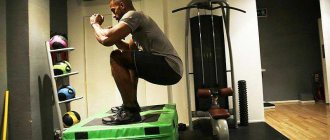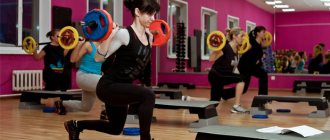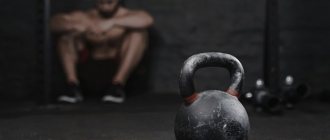© Drobot Dean - stock.adobe.com
Share:
What you need
- Barbell
- Dumbbells
- Horizontal bar
- Exercise equipment
When considering CrossFit and other areas of modern fitness, one cannot help but touch on the topic of circuit training, which is basic for many sports. What is it and how does it help beginners and professional athletes? Let's look further.
General information
Circuit training has been widely used almost from the very beginning of non-core sports disciplines. However, it received systematic justification with the development of weightlifting areas of fitness.
In particular, Joe Weider is considered one of the key figures in the development of circuit training, who created his split system as a contrast to unsystematized training. However, through opposition, he also created a basic theoretical system for substantiating circuit training, the principles on which it is based today.
Circular training for all muscle groups, according to Weider's definition, is a high-intensity training method that should involve all muscle groups and become maximum stress for the athlete's body, which will stimulate his body to further transformations.
Principles
Circular training for all muscle groups implies compliance with certain principles that distinguish it from other types of training:
- Maximum stress load. Maximum stress – stimulates the body to more intensive recovery, which allows you to achieve certain results much faster. However, at the initial stage, you should not perform every exercise to failure.
- High intensity training. Allows you to develop not only muscle strength, but also related energy systems (for example, the functioning of the cardiovascular system). There is no break between exercises in the circle or minimal – 20-30 seconds. Rest 1.5-2 minutes between circles. Number of circles – 2-6.
- Short duration. The short training time makes it accessible to most athletes. As a rule, such an activity takes 30-60 minutes (depending on the number of laps).
- Availability of strict specialization. The principles of developing circular training only imply a load on all muscle groups. The type of load determines the specialization factor of the main sport.
- Work your entire body in one workout. Typically, one exercise is allocated for each muscle group. At the same time, the order in which they are worked out changes from training to training. For example, on the first day you start with an exercise on the chest, on the second day - on the back, and so on.
- The intensity of the load on different muscle groups is determined by their size and susceptibility to loads. Basic exercises should be used primarily.
In bodybuilding and fitness, circuit training is used by beginners who find it difficult to immediately perform heavy multi-joint exercises with free weights, and during the drying phase. Gaining mass based solely on circuit training will not be effective. At this stage, the use of such a system is advisable only within the framework of load periodization.
Principles of circuit training
- Warm up before starting your workout. This is a very important part of training. Before you start working with weights, you need to properly warm up your muscles and ligaments. This will help avoid injury. And at the beginning of our career we don’t particularly need them. As in principle throughout life.
- Choose only basic exercises. It is the basic exercises that involve a large number of joints and muscles. This is good for us. After all, we are limited in the number of exercises. Therefore, it is better to perform those that bring maximum benefit.
- Duration of training. Basically, circuit training is designed for 35-50 minutes. It's simply not wise to do it any longer. Since our body needs energy not only to work in the gym, but also to recover.
- We start with large muscle groups. I wrote about them above. You should not train small muscles first. Start with such giants as legs, back, chest. And then shoulders, biceps and triceps.
- Only one exercise is performed for each muscle group. I have already spoken about the choice of exercises. These will be basic movements. We will perform one exercise for each muscle, but with high intensity.
- We do it a large number of times in each approach. The main thing here is not to reach the point of fanaticism. We do from 15 to 25 times per approach. This will help start the fat burning process and use fast and slow fibers at the same time. This way we can create a more powerful neuromuscular connection between the muscles and the brain.
- If it is difficult to work with free weights, use exercise machines. This applies more to beginners. After all, those who have just come to the gym are unlikely to be able to perform such exercises as: DEADLIFT, SQUAT WITH A BAR, or BENCH PRESS. Therefore, they can safely work in simulators to hone their technique. Provided that your hall has such equipment.
Now we have all the necessary information and can safely begin the training program itself. There are a lot of them. I will only describe to you not how long, but when you understand the principle of how this is done. Then you can choose for yourself the program that gives you the maximum result.
Varieties
Like CrossFit, circuit training is only a method of building training that does not determine the further profiling of the athlete. The foundation laid in the basic principles of such training allows you to create variability in accordance with the needs of the athlete: starting from classical training, which is used in all areas associated with weightlifting (bodybuilding, powerlifting, etc.), and ending with combined athletics training with emphasis for the development of functional capabilities (Tabata, crossfit, etc.).
Let's take a closer look at the main options for circuit training in the table:
| Type of training | Peculiarity | Method of implementation |
| Basic circular | Maximum development of strength indicators by eliminating non-core exercises. | Only basic multi-joint exercises are used. |
| Bodybuilding circular | Maximum harmonious development of the body. Use by beginners as a foundation preparation for the transition to split and by more experienced athletes for drying. | Unlike the basic circular exercise, isolation exercises can be added if necessary. Cardio may be added during the drying phase. |
| Circular in Crossfit | Maximum development of functional strength due to the specifics of performing exercises. | Combining the principles of weightlifting and athletics involves developing functional strength and endurance. |
| Athletics | Maximum development of speed indicators. | Training involves the basic development of all muscle groups with the creation of adjustments for specialization. |
| Tabata Protocol | Maximum intensity combined with minimal training time. | The principle of continuity of training and the creation of suitable intensity is observed through the formation of strict time control in conjunction with monitoring the pulse. |
You need to understand that these types are presented solely as an example, since absolutely any type of training can be built on the principles of basic circuit training. For example, workout or boxer training, each of which has a combined nature and allows you to combine the principles of Tabata and athletics, or powerlifting and CrossFit.
Specialization in the long term
Considering the exercises for circuit training and the principle of its construction, it can be noted that it is never used throughout the year by athletes. It makes sense for beginners to practice this system for 2-4 months. Experienced cutting athletes can use circuit training for 2-3 months. At the recruiting stage, it would be rational to do one week of circuit training every 4-6 weeks as part of the periodization of loads.
Using circuit training all the time is ineffective, since the body gets used to this type of load, which reduces the effectiveness of the training.
Always running program
For those who are looking for an ideal working program, we offer an example of circuit training that is suitable for experienced athletes and beginners with at least minimal experience working with iron:
| Monday | ||
| Bench press on an incline bench | 1x10-15 |
|
| One-arm dumbbell row | 1x10-15 | |
| Leg press in the simulator | 1x10-15 | |
| Lying leg curls in the simulator | 1x10-15 |
|
| Seated dumbbell press | 1x10-15 |
|
| Standing barbell curls | 1x10-15 |
|
| French bench press | 1x10-15 | |
| Wednesday | ||
| Wide grip pull-ups | 1x10-15 | |
| Dumbbell Bench Press | 1x10-15 | |
| Leg extensions in the simulator | 1x10-15 |
|
| Romanian barbell deadlift | 1x10-15 | |
| Wide grip barbell row | 1x10-15 |
|
| Dumbbell curls while sitting on an incline bench | 1x10-15 |
|
| Triceps extensions on the block | 1x10-15 |
|
| Friday | ||
| Squats with a barbell on your shoulders | 1x10-15 |
|
| Romanian deadlift with dumbbells | 1x10-15 | |
| Dips | 1x10-15 | |
| Bent-over barbell row | 1x10-15 |
|
| Close grip press | 1x10-15 | |
| Scott Bench Curls | 1x10-15 |
|
| Arnold Seated Press | 1x10-15 | |
In total, you need to perform 3-6 such circles, the first of which is a warm-up. Rest between exercises – 20-30 seconds, between circles – 2-3 minutes. In the future, you can increase the intensity of the workout by increasing the number of circles, working weights and reducing rest time. In total, the program involves its implementation for 2-3 months, after which it is better to switch to a classic split.
Note: the division by day of the week remains conditional and implies adjustment to your own training schedule. There is no need to exercise according to this scheme more than 3 times a week.
The main advantages of this approach to training include:
- Lack of specialization for certain muscle groups. This allows you to prepare the athlete’s body for loads in any specialization in the future.
- Versatility. The weight on the equipment is determined by the athlete’s preparedness.
- Short training time. Unlike other sports, canonical circuit training can be done in 30-60 minutes.
- The ability to create adjustments and replace exercises with analogues in accordance with individual preferences.
Circuit training options
Not everyone knows that circuit training is performed in different styles. Each of them affects our body differently. This is about:
Circuit training (linear training)
It looks like this: We take 6 exercises (basic). And we begin to perform them in a circle from 1st to 6th. This will be the so-called one circle. Depending on our preparation, we can do 2-4 laps. This workout is more suitable for those who are at the fat burning stage. Since our heart rate remains at a fairly high level. And the training goes at a fast pace. This type of load will be very close to cardio training. And due to the fact that we work with weights, the body will not destroy muscles first. There is only one drawback to this workout. To complete it, you need at least 6 free simulators. Not many halls can give a person such freedom in space. After all, you just have to leave the barbell or dumbbells unattended (when you move on to do another exercise). In your absence, someone may take them. But this problem can be solved. It is enough to go early in the morning while no one is there. Or late at night. Yes, not everyone will be comfortable doing this. But if you want to achieve your goal, then you need to make every effort.
Training each muscle separately
Unlike the previous version, we will perform the exercises one by one, doing a given number of approaches in each. And only then do we move on to the next one. For example: we are pumping our legs, we chose the exercise BENCH PRESS IN A SIMULATOR. We do 3-4 approaches with a break of 30-60 seconds between them. Then we move on to the next one. That is, chest or back. Before each new exercise, we rest for 1-2 minutes. This mode is best for beginners to train in. Since they still have a small amount of energy, it will be difficult to do one big approach without rest. Also, the very disadvantage of using a large number of exercise machines immediately disappears. Which makes training more comfortable.
Circular vs crossfit
CrossFit, as a fitness discipline, grew out of the principles of circuit training with a subsequent emphasis on developing functional strength. Despite the large number of athletics, gymnastics and coordination exercises in the Crossfit Games competition program, it can be noted that prize-winning places are always taken by athletes with a core specialization in heavy exercises.
Let's consider whether CrossFit is a logical continuation of the principles of constructing circuit training, whether it includes them or completely opposes them:
| Circuit training | Canonical crossfit |
| The presence of constant progression. | Lack of profiling progression. The load is determined by Wod. |
| Progression is determined by working weight, number of repetitions, circles, rest time. | Likewise. |
| Using the same exercises over a 1-2 month cycle to optimize results. | Greater variety, allowing you to develop a profiling load by constantly shocking all muscle groups. |
| Possibility to vary exercises to suit specific requirements. | Likewise. |
| Extremely short training time. | The variability of training time allows you to develop different energy systems in the body, maximizing the amount of glycogen and oxygen susceptibility of the muscles. |
| The absence of strict specialization allows you to perform all tasks. Including developing strength, endurance, burning fat, improving heart function. The only limitation is that the suitability of the program is determined by the training period. | A complete lack of specialization, which allows for the development of the functional capabilities of the body. |
| Suitable for athletes of any level of fitness. | Likewise. |
| A trainer is required to monitor the results and technique of performing the exercises. | Likewise. |
| A heart rate monitor is needed to prevent athlete's heart syndrome. | Likewise. |
| A relatively safe training method. | A rather traumatic sport that requires greater control over technique, heart rate and execution time in order to minimize risks to the body. |
| There is no need to train in a group. | The greatest effectiveness is achieved in group training. |
Based on all of the above, we can conclude that CrossFit combines the principles of circuit training, organically processing them in conjunction with other basic principles of fitness to achieve optimal results.
Circuit training is perfect as a pre-training for CrossFit classes or fits seamlessly into one of the WOD programs performed during the week.
Who is circuit training for?
Circuit training is not suitable for every athlete. No, it's not about genetics. Just on an ongoing basis, it is not very effective. But if you are one of the people listed below, then it will definitely help you. Who are we talking about?
- Beginners. For beginners, this is the most effective training program that exists. I'm talking about people who came to the hall for the first time. Their body is not yet prepared for training with the separation of muscle groups. Also, the brain cannot use the necessary neural connections to engage certain muscles in work. And of course, beginners’ execution technique will be poor. And so it will be difficult for them to understand how to do more complex isolation exercises.
- After a long break from training. This applies to all athletes of any level of training who, for some reason, had a break from training. Even 5 days of sickness or vacation is enough. In general, the reason is not important. During this time, your muscles will have time to waste a certain share of their working potential. I don’t want to go into the chemical reactions that will occur in the body during this time. But believe me, he will have time to weaken. Therefore, if you immediately give it a heavy load, you will suddenly drive yourself into overtraining. And here you can forget about proper recovery.
- If you have enough time for 1-2 workouts per week. Here it is worth immediately clarifying some points. If you go to the gym 2 times a week, and at this time you are at the stage of gaining weight. Then you can safely work according to the usual program with the separation of muscle groups. In all other cases, if there is a lack of time, a circuit program will give you the opportunity to develop the whole body. In this case, the training will take only 30-40 minutes.
- Professionals and beginners during cutting (lose extra pounds). Many professional athletes use circuit training during periods of preparation for competitions. Thanks to them, they burn excess fat and achieve their peak shape. The same goes for beginners who want to lose extra pounds. Many trainers recommend circuit training; due to its intensity, it allows you to burn fat without losing muscle mass.
Of course, if you just like circuit training, then go ahead. I don't force anyone. But still, before choosing exercises and starting to act. You need to understand what principles to use to build this program.










